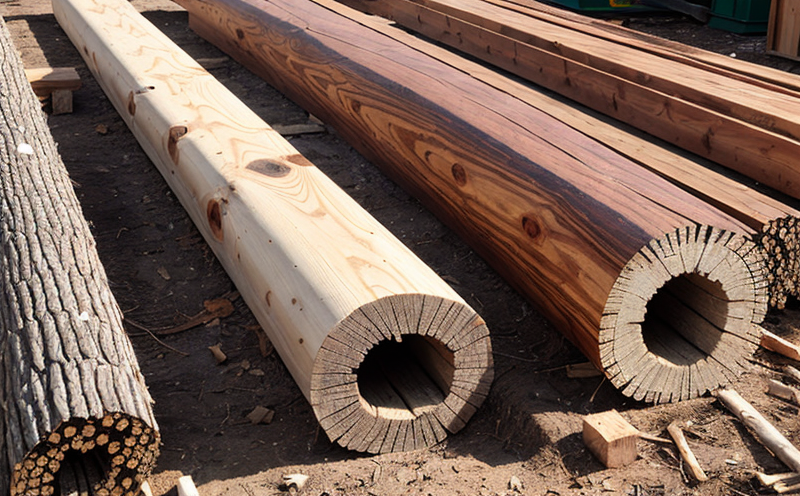Natural Durability Testing of Wood Against Fungal Decay
The natural durability of wood is a critical factor in ensuring its longevity and effectiveness in various applications within agriculture and forestry. This testing service evaluates the inherent resistance of wood species to fungal decay, which can significantly impact the performance and lifespan of wooden structures used in these sectors.
Fungi play a crucial role in the decomposition process of organic materials. Understanding the natural durability of wood against these organisms is essential for selecting appropriate timber types for outdoor applications such as fencing, landscaping, and structural components. By identifying naturally resistant species or enhancing existing woods through preservation treatments, we can extend the life cycle of wooden products.
The testing method employed follows international standards like ISO 6329 and ASTM D1418, which provide guidelines for assessing wood durability. These standards outline procedures to expose samples to controlled environments conducive to fungal growth and subsequent evaluation based on weight loss or appearance changes. This approach ensures that the results are consistent with industry benchmarks.
Preparing specimens involves selecting representative pieces of various wood types, ensuring they are free from defects and cut into standard dimensions. The testing process typically lasts several weeks to months depending on the species' natural resistance levels. During this time, samples are regularly inspected for signs of colonization by fungi before final measurements are taken.
Understanding the results provides valuable insights for material selection in agricultural equipment design or forestry infrastructure projects where moisture management and exposure conditions vary widely. For instance, tropical hardwoods like teak and ipe often exhibit high natural durability ratings due to their chemical composition which makes them less susceptible to fungal attack compared to softwoods.
Our laboratory uses advanced analytical techniques such as scanning electron microscopy (SEM) and Fourier transform infrared spectroscopy (FTIR) to analyze changes in the cellular structure of tested woods. These analyses help determine not only the extent of degradation but also provide information about potential mechanisms involved in fungal resistance or susceptibility.
In summary, natural durability testing against fungal decay is vital for optimizing resource use efficiency while minimizing environmental impacts associated with wood-based products in agriculture and forestry sectors. Through rigorous scientific methodologies combined with cutting-edge instrumentation, our team delivers accurate assessments that guide informed decision-making processes related to material specification and product development.
Scope and Methodology
The scope of natural durability testing primarily focuses on evaluating the inherent resistance of wood species against fungal decay. This involves exposing carefully prepared samples under controlled conditions designed to simulate real-world exposure scenarios. The aim is to assess how well different woods can withstand colonization by common decay fungi without compromising structural integrity.
- Specimen preparation includes cutting representative pieces from various wood types ensuring they are free from defects and cut into standard sizes suitable for testing.
- The samples undergo immersion in nutrient-rich solutions formulated specifically to promote fungal growth. This step simulates natural conditions where woods might be exposed to moisture or soil pathogens.
- Exposure periods range from a few weeks up to several months, during which time the samples are periodically inspected for signs of fungal colonization and subsequent weight loss measurements taken.
The methodology adheres closely to internationally recognized standards such as ISO 6329:1987 'Wood - Determination of resistance against fungi' and ASTM D1418-03(2015) 'Standard Practice for Testing Resistance of Wood to Fungi'. These guidelines ensure consistency across multiple testing facilities globally, providing reliable data that supports informed decisions regarding material selection.
Upon completion of the exposure period, detailed analysis is conducted using advanced microscopy techniques like SEM and FTIR. These tools allow us to examine changes at both macroscopic and microscopic levels, offering comprehensive insights into the nature and extent of fungal colonization within the wood samples.
Quality and Reliability Assurance
- We maintain strict adherence to ISO 6329:1987 and ASTM D1418-03(2015) ensuring our tests meet established industry standards.
- All specimens are prepared under standardized procedures guaranteeing uniformity in sample preparation.
- The nutrient solutions used promote consistent fungal growth across all samples facilitating accurate comparisons between different wood types.
- Periodic inspections during the exposure period ensure timely detection of any unusual developments affecting test validity.
The quality assurance process includes regular calibration and validation of analytical equipment such as SEM and FTIR to maintain precision in measurements. Additionally, internal audits are conducted periodically to verify compliance with established protocols and procedures.
Our commitment to reliability is further demonstrated by our participation in proficiency testing programs organized by recognized bodies like APLA (Association of Public Laboratory Directors). This external validation helps confirm the accuracy and consistency of our results relative to those achieved by other reputable laboratories worldwide.
Use Cases and Application Examples
| Application Scenario | Testing Requirements |
|---|---|
| Selecting appropriate wood species for outdoor furniture manufacturing | Evaluate resistance to fungal decay under simulated environmental conditions |
| Developing new composite materials incorporating recycled woods | Determine compatibility of additives with wood's natural durability properties |
| Assisting in the design of agricultural structures exposed to high humidity levels | Identify species that can maintain structural integrity despite frequent wetting events |
For instance, when designing agricultural equipment such as grain storage bins or silos, it's essential to choose wood types capable of withstanding prolonged contact with moisture without deterioration. By conducting natural durability tests according to ISO 6329:1987 and ASTM D1418-03(2015), we ensure that the selected materials meet stringent requirements for longevity and performance.
In another example, developing new composite materials using recycled woods requires understanding how these secondary raw materials interact with each other and their inherent durability characteristics. Our testing services provide data on the stability of such composites over time, helping manufacturers optimize formulas for optimal product life cycles.





